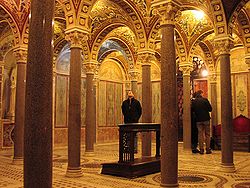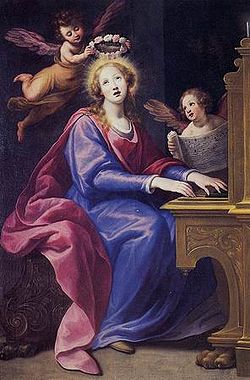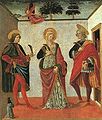Difference between revisions of "Saint Cecilia" - New World Encyclopedia
m (→Biography) |
|||
| Line 43: | Line 43: | ||
==The historical Cecilia== | ==The historical Cecilia== | ||
| − | [[Image:Albi - Sainte-Cécile - martyre de Sainte Cécile.jpg|thumb| | + | [[Image:Albi - Sainte-Cécile - martyre de Sainte Cécile.jpg|thumb|350px|Statue of Saint Cecilia in repose in the Cathedral Saint-Caecilia in [[Albi]]]] |
[[Image:Montserrat St Caecilia.jpg|thumb|125px|Mosaic of Saint Cecilia at Montserrat]] | [[Image:Montserrat St Caecilia.jpg|thumb|125px|Mosaic of Saint Cecilia at Montserrat]] | ||
One of the most venerated martyrs of Christian antiquity, the oldest historical account of Saint Cecilia is found in the ''Martyrologium Hieronymianum.'' From this work it is evident that her feast was celebrated in the Roman church already in the fourth century. However, this account is highly lengendary, and there is substantial confusion regarding her dates, as both herself and her associates seem to be confused with other martyrs of the same names. | One of the most venerated martyrs of Christian antiquity, the oldest historical account of Saint Cecilia is found in the ''Martyrologium Hieronymianum.'' From this work it is evident that her feast was celebrated in the Roman church already in the fourth century. However, this account is highly lengendary, and there is substantial confusion regarding her dates, as both herself and her associates seem to be confused with other martyrs of the same names. | ||
| Line 50: | Line 50: | ||
The ancient titular church of Rome in the Trastevere was certainly dedicated by the fifth century to the saint. Like some other ancient Christian churches of Rome, which are the gifts of the wealthy saints whose names they bear, it may be inferred that this temple was donated by the saint herself before her martyrdom. According to De Rossi's researches, the property belonged most likely to the family of Cecilia and passed into the possession of the Roman church through a later donation. | The ancient titular church of Rome in the Trastevere was certainly dedicated by the fifth century to the saint. Like some other ancient Christian churches of Rome, which are the gifts of the wealthy saints whose names they bear, it may be inferred that this temple was donated by the saint herself before her martyrdom. According to De Rossi's researches, the property belonged most likely to the family of Cecilia and passed into the possession of the Roman church through a later donation. | ||
| + | |||
| + | The Acts of the martyrdom of St. Cecilia, from which her biography is taken, originated about the middle of the fifth century and still exist in numerous ancient manuscripts. These Acts were also translated from Latin into Greek and were used in the prefaces of the above-mentioned masses. Unfortuantely, in its current form, the story has no historical value, as even sources such as the Catholic Encylopedia admit. It is a pious romance, like so many others compiled in the fifth and sixth century, replete with miracle stories and the glorification of [[spiritual marriage]]. | ||
[[Image:Ancient praying.jpg|left|thumb|300px|Ancient woman depicted in the walls of the Catacomb of Callixtus]] | [[Image:Ancient praying.jpg|left|thumb|300px|Ancient woman depicted in the walls of the Catacomb of Callixtus]] | ||
| − | |||
| − | |||
The existence of the martyrs themselves, however, is a accepted as historical fact, and the relation between Cecilia, Valerianus, Tiburtius, and Maximus probably has some historical foundation. The three saints were indeed buried on the Via Appia, but what their relationship was cannot be historically confirmed. Stories of marriages in which the couple decided to live virginally are common in Christian literature of this genre, but we cannot be certain whether which are historically based and which are legendary. | The existence of the martyrs themselves, however, is a accepted as historical fact, and the relation between Cecilia, Valerianus, Tiburtius, and Maximus probably has some historical foundation. The three saints were indeed buried on the Via Appia, but what their relationship was cannot be historically confirmed. Stories of marriages in which the couple decided to live virginally are common in Christian literature of this genre, but we cannot be certain whether which are historically based and which are legendary. | ||
Revision as of 05:42, 19 December 2008
| Saint Cecilia | |
|---|---|
Saint Cecilia by Guido Reni, 1606[1] | |
| Virgin and Martyr | |
| Born | 2nd century AD in Rome |
| Died | 176–180 or 222-235 C.E.[2] in Sicily |
| Venerated in | Roman Catholic Church Eastern Orthodox Churches Eastern Catholic Churches Anglican Communion |
| Canonized | Pre-Congregation |
| Major shrine | Santa Cecilia in Trastevere, Rome |
| Feast | November 22 |
| Attributes | flute, organ, roses, violin, harp, harpsichord, singing |
| Patronage | Church music, great musicians, poets; Albi, France;Archdiocese of Omaha, Nebraska; Mar del Plata, Argentina |
- For other uses, see Saint Cecilia (disambiguation).
Saint Cecilia (Latin: Sancta Caecilia) is the patron saint of musicians and Church music. Celebrated as a virgin martyr, her feast day is in the Roman Catholic, Eastern Orthodox, and Eastern Catholic Churches on November 22. She is one of the eight women commemorated by name in the Canon of the Mass.
Traditionally, Cecilia was believed to be a noble lady of Rome who, with her husband Valerian(us) and his brother Thateus, suffered martyrdom, c. 230, under the Emperor Alexander Severus. The research of Giovanni Battista de Rossi, however, appears to confirm the statement of Venantius Fortunatus, Bishop of Poitiers (d. 600), that she perished in Sicily under Emperor Marcus Aurelius between 176 and 180.
A church in her honor exists in Rome from about the 5th century, was rebuilt with much splendor by Pope Paschal I around the year 820, and again by Cardinal Paolo Emilio Sfondrati in 1599. It is situated in Trastevere, near the Ripa Grande quay, where in earlier days the Ghetto was located, and is the titulus of a Cardinal Priest, currently Carlo Maria Martini.
The martyrdom of Cecilia is said to have followed that of her husband and his brother by the prefect Turcius Almachius. The officers of the prefect then sought to have Cecilia killed as well. She arranged to have her home preserved as a church before she was arrested. At that time, the officials attempted to kill her by locking her in an overheated sweat-house (bathhouse). However, the attempt failed, and she was to be beheaded. The executioner attempted to decapitate her three times unsuccessfully, at which time he fled. Cecilia survived another three days before succumbing. In the last three days of her life, she opened her eyes, gazed at her family and friends who crowded around her cell, closed them, and never opened them again. The people by her cell knew immediately that she was to become a saint in heaven.[3] She was a friend to all.
The skull of Saint Cecilia is kept as a relic in the cathedral of Torcello.
Biography
Like other famous saints of the early Christian church, Saint Celilia's life is highly embellished by legend. According to her Acts, she was a virgin of a senatorial family and had been a Christian from her infancy. She was given in marriage by her parents to a noble pagan youth named Valerianus. After the their wedding celebration, the couple had retired to the bridal chamber, where Cecilia confessed that she was already betrothed to an angel who jealously guarded her body. She therefore warned Valerianus that he must take care not to violate her virginity.
Valerianus request to see this angel for himself. Cecilia sent him to the third milestone on the Via Appia where he would meet Bishop Urbanus (the pope). Valerianus obeyed was baptized by the pope, and returned to Cecilia as a Christian. The promised angel then appeared to the two of them and crowned them with roses and lilies.
When Tiburtius, the brother of Valerianus, came to them, he too was won over to Christianity. As zealous children of the faith both brothers distributed rich alms and buried the bodies of the martyrs who had died for Christ. However, the Roman prefect, Turcius Almachius, condemned the brothers to death, appointing his officer, Maximus, to execute the sentence. Maximus himself was converted, however, and suffered martyrdom with the two brothers. Their remains were buried in one tomb by Cecilia.
Cecilia herself was now sought by the officers of the prefect. After gloriously professing her faith, she was condemned to be suffocated in the bath of her own house. However, she remained miraculously unharmed in the overheated room, and the prefect had her decapitated instead. The executioner struck her neck three times with his sword without severing her head. He fled, leaving the virgin bathed in her own blood. She lived three days, made dispositions of her wealth in favor of the poor, and provided that after her death her house should be dedicated as a church. The pope then buried her among the bishops and the confessors, in the Catacomb of Callistus.
The historical Cecilia
One of the most venerated martyrs of Christian antiquity, the oldest historical account of Saint Cecilia is found in the Martyrologium Hieronymianum. From this work it is evident that her feast was celebrated in the Roman church already in the fourth century. However, this account is highly lengendary, and there is substantial confusion regarding her dates, as both herself and her associates seem to be confused with other martyrs of the same names.
The early medieval guides to the burial places of Roman martyrs point out her grave on the Via Appia, next to the crypt of the Roman bishops of the third century. The Italian archaeologist De Rossi located the her grave Catacomb of Callistus in a crypt immediately adjoining that of the popes, where an empty niche in one of the walls may have at one time held the sarcophagus with the bones of the saint. Among the frescoes of a later time with which the wall of the sepulcher are adorned, the figure of a richly-dressed woman appears twice. Pope Urban, who was associated with the saint by the Acts of her martyrdom, is depicted once.
The ancient titular church of Rome in the Trastevere was certainly dedicated by the fifth century to the saint. Like some other ancient Christian churches of Rome, which are the gifts of the wealthy saints whose names they bear, it may be inferred that this temple was donated by the saint herself before her martyrdom. According to De Rossi's researches, the property belonged most likely to the family of Cecilia and passed into the possession of the Roman church through a later donation.
The Acts of the martyrdom of St. Cecilia, from which her biography is taken, originated about the middle of the fifth century and still exist in numerous ancient manuscripts. These Acts were also translated from Latin into Greek and were used in the prefaces of the above-mentioned masses. Unfortuantely, in its current form, the story has no historical value, as even sources such as the Catholic Encylopedia admit. It is a pious romance, like so many others compiled in the fifth and sixth century, replete with miracle stories and the glorification of spiritual marriage.
The existence of the martyrs themselves, however, is a accepted as historical fact, and the relation between Cecilia, Valerianus, Tiburtius, and Maximus probably has some historical foundation. The three saints were indeed buried on the Via Appia, but what their relationship was cannot be historically confirmed. Stories of marriages in which the couple decided to live virginally are common in Christian literature of this genre, but we cannot be certain whether which are historically based and which are legendary.
Morever, the time when Cecilia suffered martyrdom is not known. The mention of "Bishop Urban" in the Acts cannot be relied on, as it is likely that the author of the Acts simply introduced the confessor of this name on account of the nearness of his tomb to those of the other martyrs and identified him with the pope of the same name. Complicating the matter even more is the fact that author of the Liber Pontificalis used the Acts for his information on Pope Urbanus. The Acts offer no other indication of the time of the martyrdom.
Some old sources place the death of the saint in the reign of [[Marcus Aurelius and Commodus (about 177 C.E.), but others place during the persecution of Diocletian. Modern scholars have suggested time of Alexander Severus (229-230), Decius (249-250), and even Julian the Apostate (362). The surest time indication is the position of the tomb in the Catacomb of Callistus, in the immediate proximity of the very ancient crypt of the popes. The earliest part of this catacomb dates from the end of the second century. From that time, therefore, to the middle of the third century is the period left open for the martyrdom of Saint Cecilia.
In the Sacramentarium Leoniam, a collection of masses completed about the end of the fifth century, no less than five different masses are found in honor of Cecilia.
Later cult and legacy
Her church in the Trastevere quarter of Rome was rebuilt by Pope Paschal I (817-824). The pope wished to transfer her relics to this location, but at first he could not locate them and believed that they had been stolen by the Lombards. In a vision, he saw Cecilia, who exhorted him to continue his search, as he had already been very near her grave. Soon the body of the martyr, draped in costly material of gold brocade and with the cloths soaked in her blood at her feet, was found in the Catacomb of Prætextatus. They were thought to have been transported there from the Catacomb of Callistus to save them from earlier depredations of the Lombards in the vicinity of Rome.
The relics of Saint Cecilia—together with those of Valerianus, Tiburtius, and Maximus, as well as those of pope Urban and Lucius, were then reburied under the high altar of St. Cecilia's church in Trastevere. From this time on, the veneration of the martyr continued to spread, and numerous churches were dedicated to her.
During the restoration of the church in the year 1599, Cardinal Sfondrato had the high altar examined and found under it the sarcophagi, with the relics of the saints. Twentieth-century excavations beneath the church disclosed the remains of Roman buildings. A richly adorned underground chapel was found beneath the middle aisle, and in it a latticed window, opening over the altar, allowing a view of the receptacles in which the bones of the saints were laid. In a side chapel of the church can be seen the remains of the bath in which, according to the Acts, Cecilia was put to death.
The oldest representations of Saint Cecilia show her in the attitude usual for martyrs in the Christian art of the earlier centuries: either with the crown of martyrdom in her hand or in the attitude of prayer. In the apse of her church in Trastevere is still preserved the mosaic made under Pope Paschal, wherein she is represented in rich garments as patroness of the pope. Medieval pictures of the saint are very frequent.
Patroness of church musicians
Since the fourteenth and fifteenth centuries she is represented as playing the organ, evidently to express the idea that while musicians played at her wedding, she sang in her heart to God alone. When the Academy of Music was founded at Rome (1584) she was made patroness of the institute, whereupon her veneration as patroness of church music in general became more universal. The organ is now her most usual attribute. Raphael with painted her with this instrument in a painting preserved at Bologna.
Cecilia's musical fame rests on a passing notice in her legend that she praised God, singing to him, as she lay dying a martyr's death.

The connection between her and the art of which she has become the patron saint does not seem to date back much before the fifteenth century. By the second half of the sixteenth century, substantial festivals and musical celebrations in her honor began to be recorded in Europe, the earliest of them in Normandy. A century later, this fashion crossed the channel to England with the festivities of 1683 attracting three celebratory odes in her honor, all set to music by Henry Purcell.
Other music dedicated to Cecilia includes Benjamin Britten's Hymn to St. Cecilia, based on a text by W. H. Auden; A Hymn for St Cecilia by Herbert Howells; a mass by Alessandro Scarlatti; Charles Gounod's Messe Solennelle de Sainte Cécile; Hail, bright Cecilia! by Henry Purcell; and an opera, Cecilia, by Licinio Refice, SJ (1934).
Sankta Cecilia is the title of a 1984 Swedish hit song sung by Lotta Pedersen and Göran Folkestad at the Swedish Melodifestivalen 1984. Additionally, the American pop-rock band Jars of Clay opened their 2007 Christmas Songs album with an instrumental track titled "The Gift of St. Cecelia."
Other art and literature
Innumerable paintings and stained glass windows depict her at the organ or holding a violin, instruments she could not have personally known. She is represented in the The Ecstasy of St. Cecilia by Raphael at Bologna, Rubens in Berlin, the Domenichino in Paris and at San Luigi dei Francesi, and works by Artemisia Gentileschi.
In literature, she is commemorated especially by Chaucer's Seconde Nonnes Tale, and by John Dryden's famous ode, set to music by Handel in 1736, and later by Sir Hubert Parry (1889).
In another magnificent masterpiece, the marble statute beneath the high altar of the above-mentioned church of St. Cecilia at Rome, Carlo Maderna represented her lying prostrate, just as she had received the death-blow from the executioner's hand.
Her feast is celebrated in the Latin and the Greek Church on 22 November. In the "Martyrologium Hieronymainum" are commemorated other martyrs of this name, but of none of them is there any exact historical information. One suffered martyrdom in Carthage with Dativus in 304.
St Cecilia was featured on the reverse of the £20 note in the United Kingdom, from 1999 to 2007, together with composer Sir Edward Elgar.
Meaning of the name
Traditionally translated from Latin as, "The way for the blind," the meaning of the name "Cecilia" as given by Chaucer in The Seconde Nonne's Tale from The Canterbury Tales, has five interpretations, each poetically describing various virtues and qualities of the Saint. They are: lily of heaven; the way for the blind; contemplation of heaven and the active life; as if lacking in blindness; a heaven for people to gaze upon. Nonetheless, these etymologies are spurious.
See also
- St. Cecilia Cathedral, Omaha, Nebraska
- The Incorruptibles
Gallery
- St Cecilia-Waterhouse.jpg
In a clear walled city on the sea. Near gilded organ pipes - slept St. Cecily
Notes
- ↑ St Cecilia by RENI, Guido
- ↑ "The Saint Andrew Missal, with Vespers for Sundays and Feasts," by Dom Gaspar LeFebvre, O.S.B., Saint Paul, MN: E. M. Lohmann Co., 1952, p. 1685
- ↑ Cite error: Invalid
<ref>tag; no text was provided for refs namedCE
ReferencesISBN links support NWE through referral fees
External links
- The Golden Legend: The Life of Saint Cecilia
- Patron Saints Index: Saint Cecilia
- Catholic Online - Saints & Angels: St. Cecilia
- Order of Saint Cecilia
Credits
New World Encyclopedia writers and editors rewrote and completed the Wikipedia article in accordance with New World Encyclopedia standards. This article abides by terms of the Creative Commons CC-by-sa 3.0 License (CC-by-sa), which may be used and disseminated with proper attribution. Credit is due under the terms of this license that can reference both the New World Encyclopedia contributors and the selfless volunteer contributors of the Wikimedia Foundation. To cite this article click here for a list of acceptable citing formats.The history of earlier contributions by wikipedians is accessible to researchers here:
The history of this article since it was imported to New World Encyclopedia:
Note: Some restrictions may apply to use of individual images which are separately licensed.











